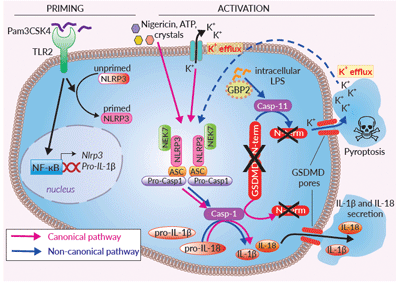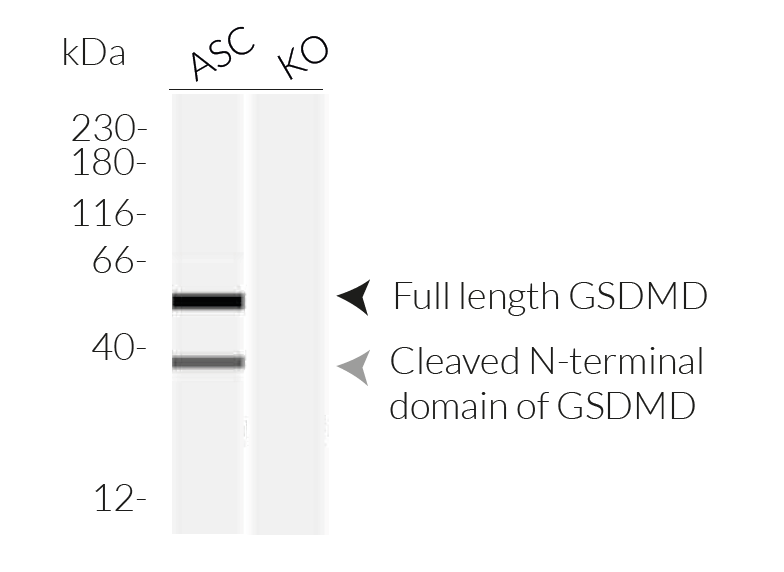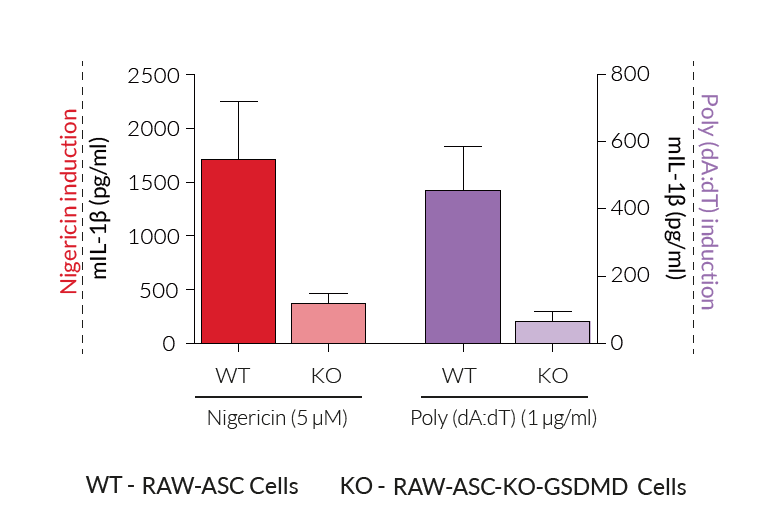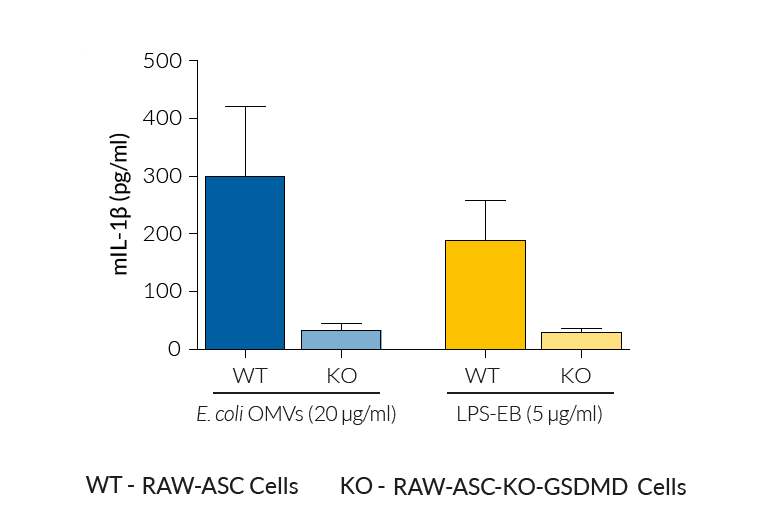Gasdermin-D KO RAW-ASC Cells
| Product | Unit size | Cat. code | Docs. | Qty. | Price | |
|---|---|---|---|---|---|---|
|
RAW-ASC KO-GSDMD Cells GSDMD Knockout & ASC expressing RAW 264.7 cells (murine macrophages) |
Show product |
3-7 x 10e6 cells |
raw-kogsdmd
|
|
||
|
RAW-ASC KO-GSDMD vial Additional cell vial |
Show product |
3-7 x 10e6 cells |
raw-kogsdmd-av
|
Notification: Reference #raw-kogsdmd-av can only be ordered together with reference #raw-kogsdmd.
Gasdermin D knockout in RAW 264.7 cells

Inflammasome signaling in RAW-ASC KO-GSDMD cells
Gasdermin D (GSDMD) is a cytoplasmic protein with a pore-forming ability that has been described as a major actor in both canonical and non-canonical inflammasome responses [1, 2].
To foster studies on GSDMD, InvivoGen has developed RAW-ASC KO-GSDMD cells, which were generated from the RAW-ASC cell line that derives from the naturally ASC deficient RAW 264.7 macrophage cell line [3]. RAW-ASC KO-GSDMD cells stably express the transfected murine ASC gene and have a stable knockout of the gasdermin D (GSDMD) gene.
• RAW-ASC KO-GSDMD cells – Knockout (KO) of the GSDMD gene and expression of the murine ASC gene
In this cell line, both mature IL-1β secretion and pyroptotic cell death are abolished upon canonical and non-canonical inflammasome activation. This cell line is a useful tool to study the role of GSDMD in the inflammasome responses and is an alternative to the in vitro differentiation of mouse bone-marrow-derived macrophages. Additionally, it can be used as a control cell line for the screening of novel therapeutics that target GSDMD.
FEATURES OF RAW-ASC KO-GSDMD CELLS:
- Verified biallelic knockout of the GSDMD gene and stable expression of the ASC gene (Western blot)
- Complete abrogation of mature IL-1β secretion and pyroptosis after canonical and non-canonical inflammasome activation
![]() Download our Practical guide on Inflammasomes
Download our Practical guide on Inflammasomes
References:
1. Feng S. et al., 2018. Mechanisms of Gasdermin family members in inflammasome signaling and cell death. J. Mol. Biol. 430:3068.
2. Kovacs S.B. & Miao E.A. 2017. Gasdermins: effectors of pyroptosis. Trends Cell. Biol. 27:673.
3. Pelerin P. et al., 2008. P2X7 receptor differentially couples to distinct release pathways for IL-1β in mouse macrophage. J. Immunol. 180:7147.
Specifications
Antibiotic resistance: Blasticidin
Growth medium: DMEM, 4.5 g/l glucose, 4 mM L-glutamine, 10% heat-inactivated fetal bovine serum (FBS), 100 U/ml penicillin, 100 µg/ml streptomycin, 100 µg/ml Normocin™
Test medium: DMEM without phenol red, 4.5 g/l glucose, 4 mM L-glutamine, 10% heat-inactivated FBS, 100 U/ml penicillin, 100 µg/ml streptomycin.
Note: Phenol red causes high background signal in the LDH (lactate dehydrogenase) assay used to monitor inflammasome-induced cell death.
Quality Control:
- Biallelic GSDMD knockout has been verified by Western blot (Wes™) and functional assays.
- The stability for 20 passages, following thawing, has been verified.
- These cells are guaranteed mycoplasma-free.
Contents
- 3-7 x 106 RAW-ASC KO-GSDMD cells in a cryovial or shipping flask
- 1 ml of Normocin™ (50 mg/ml). Normocin™ is a formulation of three antibiotics active against mycoplasma, bacteria, and fungi.
- 1 ml of Blasticidin (10 mg/ml)
![]() Shipped on dry ice (Europe, USA, Canada and some areas in Asia)
Shipped on dry ice (Europe, USA, Canada and some areas in Asia)
Details
GSDMD belongs to a family of six and ten gasdermins in humans and mice, respectively, which all have different expression patterns [1, 2]. GSDMD consists of two distinct domains, whereby the C-terminal domain exerts an auto-inhibitory function on the N-terminal domain.
GSDMD is cleaved by activated caspase-1 (CASP1) downstream of NLRP1, NLRP3, AIM2, NLRC4, or Pyrin canonical inflammasomes, or by activated CASP4/5 (human), CASP11 (mouse) non-canonical inflammasomes. The released GSDMD N-terminal domain oligomerizes to form 10-15 nm diameter pores at the cell membrane, thereby allowing the release of alarmins (e.g. HMGB1) and the secretion of mature IL-1β and IL-18 inflammatory cytokines. The accumulation of GSDMD pores in the membrane causes cell swelling and rupture, leading to an inflammatory cell death termed pyroptosis [1, 2].
Importantly, GSDMD links the canonical and non-canonical inflammasome responses with the pore formation leading to stress signals, such as cytosolic ion concentration imbalances (i.e. K+ efflux) and ATP release. These signals induce the activation of NLRP3 and CASP1-mediated IL-1β/IL-18 maturation and secretion [3, 4].
1. Feng S. et al., 2018. Mechanisms of Gasdermin family members in inflammasome signaling and cell death. J. Mol. Biol. 430:3068.
2. Kovacs S.B. & Miao E.A. 2017. Gasdermins: effectors of pyroptosis. Trends Cell. Biol. 27:673.
3. Groslambert M. & Py B. 2018. Spotlight on the NLRP3 inflammasome pathway. J. Inflamm. Res. 11:359.
4. Mathur A. et al., 2017. Molecular mechanisms of inflammasome signaling. J. Leuk. Biol. 103:233.










